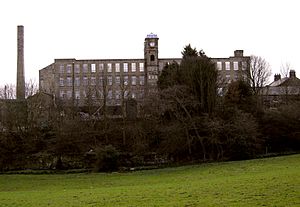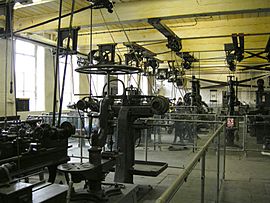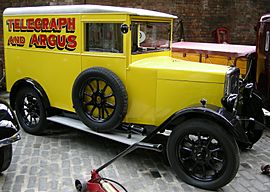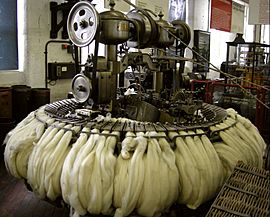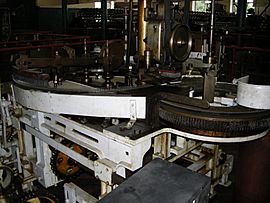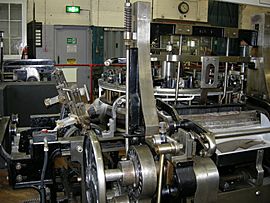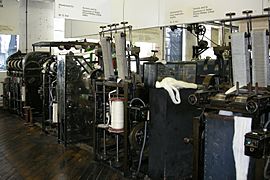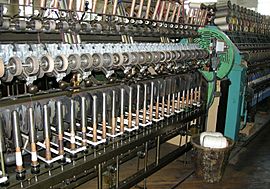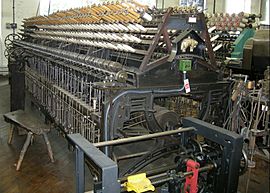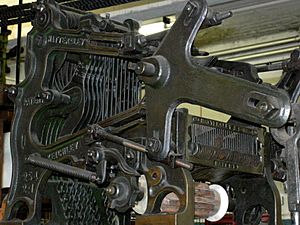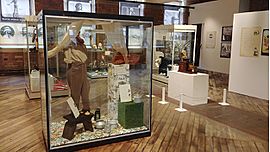Bradford Industrial Museum facts for kids

Museum entrance on Moorside Road
|
|
| Established | 1974 |
|---|---|
| Location | Moorside Mills, Moorside Road, Eccleshill, Bradford BD2 3HP |
| Type | Industrial museum, Mill museum, Textile museum, |
| Public transit access | Bus and train: Bradford Interchange |
The Bradford Industrial Museum is a cool place to visit in Bradford, United Kingdom. It opened in 1974 inside an old factory called Moorside Mills. This museum shows off amazing machines and tools from local industries, especially printing and textiles. Many of these machines still work! You can see them in action during special demonstrations. There's also a Horse Emporium and a shop. The best part? Entry is free!
Contents
History of the Museum Building
The building where the museum is, Moorside Mills, was once a busy textile factory. It was built in 1875 by John Moore. This factory made a special type of wool yarn called worsted. About 100 people worked there.
The mill first used steam power, but later switched to electricity in the early 1900s. During World War I, there was a huge need for worsted wool for military uniforms. This led to the factory growing bigger, adding two more floors and a clock tower. The clock tower was put up in 1919 as a war memorial.
In 1929, the mill was sold to W & J Whitehead. They used a special machine called a ring spinning machine, which you can still see in the museum today. In 1970, the local council bought the mill. It officially opened as a museum on December 14, 1974.
Ground Floor Galleries
Power Machines
This part of the museum shows machines from the 1800s, when the Industrial Revolution was happening. You can see waterwheels, steam engines, and engines that ran on oil and gas. There's also a display of an engineer's workshop.
One interesting item is a large millstone from an old corn mill. It was used to grind grain into flour. The museum also has a "Linton engine," which was one of the last steam engines made in Bradford. You can learn all about the history of steam power here.
Transport

This gallery is full of old cars, vans, motorbikes, and bicycles made by companies from Bradford. You can see classic cars from the Jowett company and Scott motorbikes. There's also a big steam roller from 1928 that was used by the Bradford City Council.
The biggest item here is a steam locomotive named Nellie. She was built in 1922 and used to carry materials at a sewage works. Nellie is a very strong engine, weighing 28 tons! She could carry 700 gallons of water in her tank.
In the tram shed, you'll find the only tramcar left from Bradford, plus a Bradford trolleybus. Horse-drawn trams started in Bradford in 1882, then steam trams, and finally electric trams in 1898. Trolleybuses ran from 1911 to 1972. You can see tramcar no. 237, built in 1904, which could carry 38 passengers.
Print Shop
This gallery has different types of old printing machines that still work! You can see how newspapers and books were made a long time ago.
There are machines used for "hot metal typesetting," which was how newspapers used to set their words. One machine, called a monotype keyboard, made special paper tapes. These tapes told another machine how to cast each letter out of metal. You can even see a metal "forme" of the front page of an old newspaper, ready to be printed.
The museum also shows lead letters, called glyphs, that were used for typesetting. These letters would be arranged backwards and upside down, then inked and pressed onto paper to print text. You can see different kinds of printing presses, including a large Wharfedale press.
First Floor Textile Galleries
In the 1800s, Bradford was famous for its worsted cloth. These displays show how raw wool was turned into fabric, step by step.
Spinning Gallery
Preparing Wool
"Preparing" is the first step for long wools and hairs. It gets the fibers ready for the next stage. The museum shows machines that take the wool and turn it into a continuous strand, called a "sliver." This sliver is then ready for the combing machine.
Combing Wool
Combing makes the wool fibers straight. It separates the long, good fibers (called "tops") that are used for spinning from the short, unwanted ones (called "noil"). The museum has different types of combing machines, like the Noble comb, Lister comb, and Holden comb. The Noble comb was very popular because it could comb many different lengths of wool.
These machines use pins and rollers to pull the fibers straight and remove any short bits or dirt. The long, combed fibers are then collected into a can, ready for the next step.
Drawing and Finishing Wool
After combing, the thick "slivers" of wool go through machines called "gill boxes." These machines make the slivers thinner and more even. This process is called "drawing." It prepares the wool, now called "roving," for spinning.
The machines use rollers that spin at different speeds to stretch the wool fibers. The roving then gets a slight twist for strength and is wound onto bobbins. This "finishing" process also adds moisture to the wool, making it soft and ready to be sold to spinners.
Spinning Wool
Spinning is the last step to turn wool into yarn. The roving is stretched to its final thickness, and twist is added to make it strong. There are three main types of spinning machines: flyer, cap, and ring.
All these machines stretch the roving between rollers. The front rollers spin faster than the back ones, pulling the roving thinner. Small carriers help control the fibers as they are stretched.
The museum has examples of flyer spinners and twisters. The flyer machine is an older type, good for thick, smooth yarns. The cap frame was an improvement, allowing for faster production and finer yarns. There's also a velox ring spinner, which was a later development, making even smoother yarn. These machines show how yarn was made for weaving and knitting.
Weaving Gallery
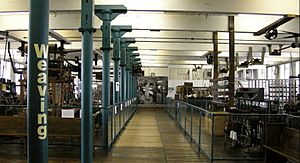
This gallery shows the amazing machines used for weaving during the Industrial Revolution. Weaving is the process of making cloth by interlacing two sets of yarns.
Sometimes, old factory workers used special words for parts of the machines. For example, a "treadle" was a pedal pushed by a worker's foot. This pedal powered a moving beam, which then powered other parts of the machine, like the "lams" that helped work the "yelds" (parts that lift the threads).
Home Looms
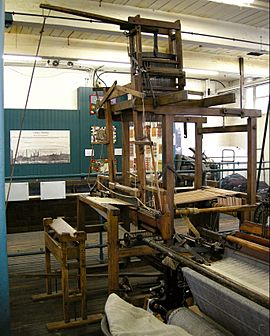
You can see hand looms here, like those used by cloth designers to create new patterns. These looms are still used today in colleges to teach students about fabric design. Some have a "witch," which is an early type of "dobby" machine. This helps lift many threads to make complex patterns.
The "flying shuttle" method, invented in 1733, made weaving faster. It allowed the weaver to send the "weft" (crosswise thread) through the loom easily. Later, a "multiple shuttle box" was invented, allowing up to four colors to be woven at once.
Another handloom has a "jacquard" attachment. This allowed weavers to create very complex fabrics with detailed patterns. These home looms were slowly replaced by all-metal looms and the factory system during the Industrial Revolution.
The plain Hattersley Domestic Loom was made for home use around 1900. It was faster and easier to use than older wooden handlooms. Even though it used foot pedals, it was much more efficient because its parts were connected by gears. This loom used only one shuttle, making solid-colored cloth.
Factory Power Looms
The Hattersley 6 × 1 revolving skip box loom was used to weave fabrics for suits. It had a "dobby" device, which helped lift and lower the threads to create patterns. Hattersley also invented the "skip box," which allowed the shuttle to skip compartments and pick out a specific shuttle.
The Dobcross H.K. box loom, made around 1950, was very popular in the wool industry. It could weave many different types of cloth, from light suit fabrics to heavy blankets. This loom also had a "dobby" that lifted and lowered the threads. It could use up to seven shuttles, each with a different color.
The Sowden worsted coating loom had special new features to make it more efficient. Its dobby allowed the threads to stay open longer, giving the shuttle more time to pass through. This loom could also weave a brand name or country of origin into the edge of the cloth, called the "selvedge." The word "selvedge" means "self-edge," as it's the natural edge of the fabric.
Outside Areas
The first owner of Moorside Mills, John Moore, lived in Moorside House until 1887. Later mill owners also lived there. Today, the house is a museum display, showing how a mill owner's family lived in the 1800s. Gaythorne Row is a group of Victorian "back-to-back" houses. They were rebuilt here in 1986 and are furnished to show how mill workers lived in the 1870s, 1940s, and 1970s.
The Horse Emporium used to be the mill's canteen. Now, it has displays about horse power. You can see a heavy-duty British Rail dray (a type of wagon), tools for cutting horse food, and a display of a saddler at work. There are also horse brasses, horseshoes, and other horse harness items. In a stable, you'll find a blacksmith's workshop where horseshoes were made, complete with anvils and metalworking tools.
Stables

This building was a car garage in 1918. The museum used to keep dray horses here until 2011. Now, it holds restored horse-drawn vehicles. You can see a copy of an 1890 "garden seat omnibus," which was a bus with wooden seats on top. These were used in the UK until 1931.
There's also a "brougham," a light, one-horse carriage from the 1800s. It was named after Lord Chancellor Brougham. Another cool exhibit is a "steamer," or Shand Mason steam fire pump from around 1880. Horses pulled it, and steam powered it to pump 250 gallons of water per minute! Firemen could get it ready in just 7 minutes. These steam pumps were very successful and sold worldwide, but they used a lot of coal and horses. Motor pumps replaced them around 1900.
Temporary Exhibitions and Events
The museum often hosts fun events like living history days and family activities. Every year, there's a Victorian-style Christmas craft market. They also have regular temporary exhibitions. For example, in 2003, there was a motorcycle exhibition, and in 2009, a display of rag-rugs.
The museum offers educational workshops for schools and groups. These include a Victorian classroom, a World War II classroom, and "washday" sessions where you can learn about old laundry methods.
In 1973, the museum held the first solo exhibition of Edna Lumb's artwork. She was famous for painting industrial scenes, like engines and factories. A look back at her work was held in 1991.
From December 2013 to November 2014, the museum had an exhibition called "A Masonic Experience." This showed items from Freemasonry, a social group that started from old stonemason guilds. The exhibition included a copy of a Masonic Lodge room and colorful Masonic aprons.
A special item in that exhibition was a fancy robe worn by Sarastro in The Royal Opera House London's show of Mozart's The Magic Flute. Mozart became a Freemason in 1784, and some of his works, like The Magic Flute, are thought to have Masonic ideas in them.
As of August 2025, the museum is showing items from Fountains Café. This café was a business that ran for 55 years before closing in 2023. The exhibition includes old furniture, signs, and artwork from the café. The café was even used as a filming location for TV shows like The Great Train Robbery and Funny Cow.
See also
- Bradford District Museums & Galleries


